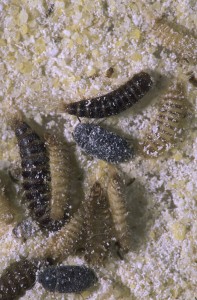 Q: A residential customer has a phorid fly problem. The house is on a slab. The drain lines have been snaked and examined with a camera, but no breaks were found. Several thorough inspections have failed to find another source. Before I take a great risk and have the slab broken, is there anything else I can do to pinpoint the source of the infestation? Almost the entire slab is covered with ceramic tile. I’ve dealt successfully with several of these problems before, but would always find a broken waste line without breaking up the slab. T.S., Ore.
Q: A residential customer has a phorid fly problem. The house is on a slab. The drain lines have been snaked and examined with a camera, but no breaks were found. Several thorough inspections have failed to find another source. Before I take a great risk and have the slab broken, is there anything else I can do to pinpoint the source of the infestation? Almost the entire slab is covered with ceramic tile. I’ve dealt successfully with several of these problems before, but would always find a broken waste line without breaking up the slab. T.S., Ore.
A: Another option for locating the problem beneath the slab is to drill 3/8-in. holes through the grout between the ceramic tiles and through the slab. Place clear plastic cups over the holes to see if any phorids are trapped within 24 hours. Place the holes 10 to 20 ft. apart. If the plumber who used the camera in the lines can be contacted, he probably can draw a rough sketch of their position. If so, drill near the suspected position of the lines. If a hole is drilled close to the problem, flies likely will emerge immediately, and you won’t need to use plastic cups. Because you’ve dealt with phorids under slabs before, you know you’ll need to break open the slab at points of infestation and remove all of the contaminated soil. If you don’t find any flies emerging from your drill holes, I wouldn’t break up the slab because the source must be somewhere else.
Q: I know migrating cockroaches can infest restaurants attached to other businesses. But would you agree cockroaches found in freestanding restaurants are brought in with goods (food, paper, etc.)? I’m trying to educate my clients who operate these types of restaurants. J.B., N.Y.
A: In many cases, I’d say you’re correct: Cockroaches are transported into many establishments with food and paper goods. However, employees sometimes also are guilty of bringing in cockroaches via their clothing and personal belongings. If there are employee lockers in the restaurant, check them for signs of infestation. If cockroaches are present, have the lockers emptied periodically and treated with a residual.
Q: A residential customer finds black carpet beetle larvae in a second-floor bedroom. They crawl up the wall and accumulate on a windowsill. A careful inspection has failed to find a source. The home is about 20 years old and immaculate. There are few, if any, cracks and crevices, and paint has filled such openings. Any thoughts about a source and treatment? J.B., W.V.
A: Black carpet beetles are primarily scavengers and usually cause little damage. They often breed in accumulations of lint behind baseboards. This home might be a little new for such accumulations, though. Check the attic for an old bird’s nest or similar debris. Was there ever a bee colony in that wall? Apply a crack-and-crevice treatment in the room — assuming you don’t locate a source — and see what happens. If the problem persists, you might have to drill and dust wall voids around that window.
You can reach Dr. Mampe, an industry consultant, at dentomol@aol.com.
Email your questions about insect identification and pest management technologies and techniques to Dr. Mampe at detomol@aol.com. Your questions most likely will be printed and answered in one of Pest Management Professional’s upcoming Ask the Expert columns.

Leave A Comment